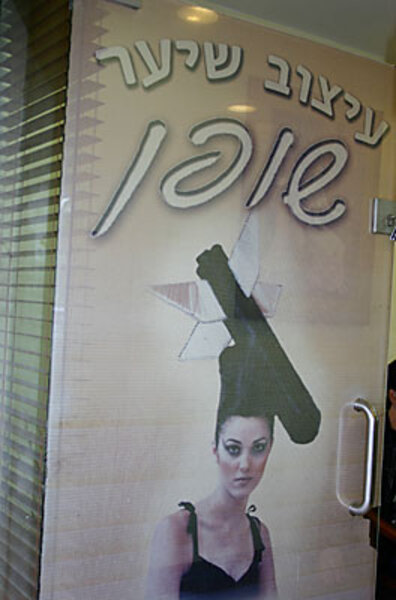In Israel, embattled Sderot comes back to life after rocket barrages of Gaza war
| Sderot, Israel
It's raining cats and dogs in Sderot, but that's a welcome development. This time last year it was raining Qassam rockets by virtue of the fact that Sderot is the closest population center to northern Gaza, bringing it within range of Palestinian militants.
Sderot bore the brunt of rocket attacks during Israel's 2008 offensive in Gaza - 50 to 60 rockets per week were fired at the small southern city at the height of the conflict, out of a total of 800 fired at communities all over southern Israel during the three-week war. About half the city's residents left, while the other half spent their days rushing in and out of bomb shelters in the few seconds' warning they got from the town's alarm system.
Today, the rattled little city that was a ghost town a year ago is coming back to life. A new shopping mall is going up, and a large sports complex opened a few months ago, thanks largely to donor aid. Concern for the city's threatened residents that grew over the past decade has brought extra help, to the point where Sderot now has better community, educational, and recreational services than most other southern "development towns." The term "development towns" refers to the effort to bring Israelis to peripheral areas of the country the government wanted to see settled.
Now, demand for apartments here far outweighs supply. Even though the price of an average small apartment here has doubled, according to real estate agents, it's still far cheaper to buy a home here than almost anywhere else in the region. "There's a great demand for apartments, because you can't get these prices anywhere else in the area. There aren't enough apartments to sell, and that means people want to live here and invest here," says Alex Aviram, a real estate agent.
"But I wouldn't call it a boom just yet," says Mr. Aviram. "We know quite well what it is to live with the boom, day after day," he says, making a joke out of life under rocket fire – and the sound of a Qassam rocket landing.
Born in Uzbekistan, Aviram moved to Israel 20 years ago, and in 1995 came to Sderot, long before it was considered a front-line community. He says that Adam, his five-year-old son, has suffered from growing up under the threat of rockets and the constant sounding of alarms. The situation does, he admits, make some potential clients think twice about moving here.
Dark humor
Dark humor, it seems, is a specialty in Sderot. At the Chopin hair salon in the center of town, the owners gave a model a Qassam-shaped hairdo and have featured a poster of it as their signature advertisement on the front door.
"There's no optimism here," says hair-cutter George Mataev. "The government doesn't give citizens here any sense of security. What the [Israeli] army did in Gaza a year ago was just temporary, and as soon as we make prisoner exchange deal over Gilad Shalit, the rockets will probably start again."
David Bouskila, the mayor of Sderot, certainly hopes that's not true. He gushes about how much the city has bounced back to life in the year after the war. In an interview in his office, where he has a lamp whose base is an expired Qassam rocket, he points out that there are still one or two rockets launched per month at Sderot, despite the cease-fire. (Israel's Ministry of Foreign Affairs says 127 rockets and 70 mortar shells have been fired into Israel since the cease-fire that went into effect on Jan. 18.)
"We're trying to renovate not just homes and buildings that were damaged, but to help people get back to normal as well," Mr. Bouskila says. "About 7,000 residents here are suffering from post-traumatic stress, and it's not so easy for all of us to live not knowing what might happen tomorrow. I think people here are starting to believe that the problem with Gaza can be solved, but it must be a political solution, not a military solution."
While Sderot repairs and rebuilds, however, nearby Gazans have seen scant progress in their own reconstruction, despite the international donor community pledging approximately $5.2 billion in aid following the war. One of the main barriers to major rebuilding projects is the lack of cement and steel, which Israel has barred from entering Gaza through its borders. That is a decision that Bouskila defends.
"If you bring them cement and iron, they will produce Qassams, and we will find ourselves helping our enemies to destroy us," he says. "No one in Sderot enjoys the suffering of people in Gaza. But no one can guarantee us that any cement or iron we give them won't become the next Qassam. I think our national leaders know what's best from the security side, and my job is to take care of the quality of life of my people."
On Thursday, several hundred local activists, residents and rocket attack victims attended a "Sderot Rally for Hope." They marched to a lookout point over Gaza, and released white balloons with attached messages of hope, written by local 4th- and 5th-graders to children in Gaza.
"It's a symbolic gesture, but it's a sign that there are people here who definitely want to live in peace with our neighbors," says Anav Silverman, a spokeswoman for the Sderot Media Center and one of the organizers of the event. "Dec. 31 being the last day of 2009, we think it's a great way to open the new year and a new decade: with hope."







